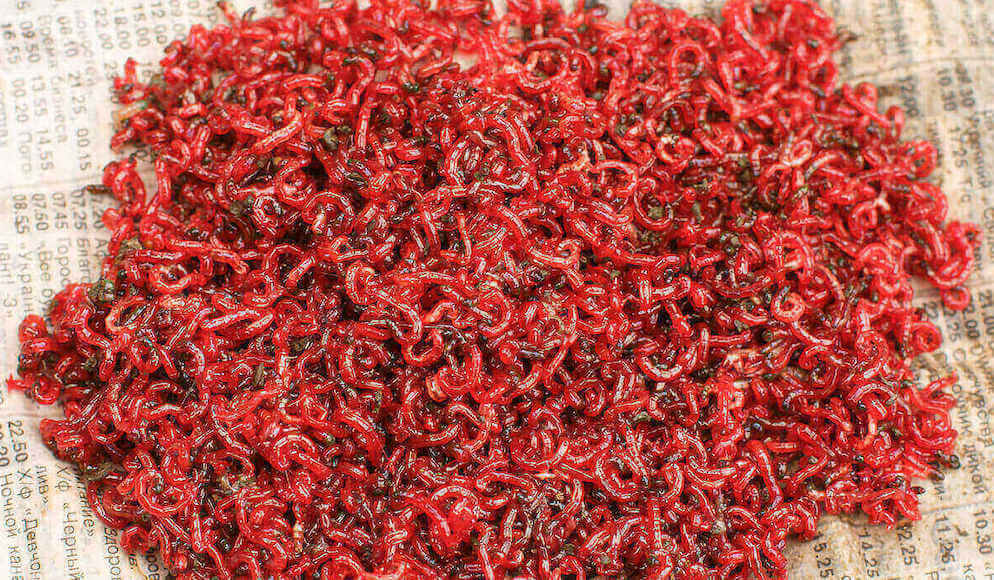Bloodworms typically refer to either the small red larvae of midge flies (Chironomidae) or marine bristle worms from the genus Glycera.
While Chironomidae larvae are non-aggressive and commonly used as fish food, Glycera worms are predatory and found in marine environments. Both types are popular among fish keepers and anglers and can be purchased frozen or alive from markets and pet stores.
What Do Bloodworms Look Like?
Chironomidae Larvae (Freshwater Bloodworms):
Chironomidae larvae are red due to high concentrations of hemoglobin, allowing them to thrive in low-oxygen environments often found in polluted waters. These larvae are generally small, usually less than 10 cm in length, and possess simple mouthparts adapted for filter feeding. They do not have venomous jaws and are non-aggressive, making them safe for handling and ideal as fish food.
Glycera Bristle Worms (Marine Bloodworms):
In contrast, marine bristle worms from the genus Glycera can grow significantly larger, up to 35 cm (14 inches) in length. They have distinct physical features, including eversible proboscises equipped with fang-like jaws that can inject venom. These worms are predatory and can pose a threat to small fish and other marine life. While not typically sold commercially for fish food, their aggressive nature makes them unsuitable for most aquarium settings.
Types of Bloodworms
Live Bloodworms (Chironomidae Larvae)
Live bloodworms, primarily the larvae of non-biting midges (Chironomidae), are popular among fish keepers and anglers. They are ideal for feeding a large number of fish in sizable tanks due to their high protein content.
These larvae are fresh and retain more vitamins and minerals compared to processed forms. However, their shelf-life is limited, typically lasting 10-12 days before they begin to deteriorate. It’s advisable to use purchased live bloodworms within 2-3 days to ensure freshness.
Advantages
Cautions
Frozen Bloodworms
Frozen bloodworms are highly popular among fish keepers due to their convenience and longer shelf-life. They are typically available as frozen blocks or thin sheets, making storage and portioning easy. Frozen bloodworms are generally more affordable than live ones and can be stored in the freezer for up to six months without significant loss of nutritional value.
Advantages
Cautions
- Good for Marine, Tropical, Coldwater, Cichlid, and Discus
- High quality frozen food for aquarium fish
- 100% natural products that your fish will recognize and enjoy
- Gamma ray irradiated – pathogen free
- 100% safe to store in your freezer
Last update on 2025-04-12 / Affiliate links / Images from Amazon Product Advertising API
Freeze-dried Bloodworms
Freeze-dried bloodworms undergo a dehydration process that reduces their nutritional content compared to live and frozen bloodworms. Despite this, they remain a convenient and long-lasting option for fish food. Typically packaged in small plastic tubs, freeze-dried bloodworms can be stored easily and have an extended shelf-life.
Usage Tips:
- Rehydration: Soak freeze-dried bloodworms in water for several minutes before feeding to soften them and prevent them from floating on the tank’s surface.
- Types: Available in Grade A (higher quality) and Grade B (lower quality), allowing fish keepers to choose based on their feeding preferences and needs.
Last update on 2025-04-12 / Affiliate links / Images from Amazon Product Advertising API
Uses of Bloodworms
Fishing
Bloodworms are renowned as effective fish bait for both freshwater and saltwater fishing. Their creamy, meaty texture makes them highly attractive to predatory fish species, including trout, perch, bass, and various saltwater species like weakfish and striped bass. Both Chironomidae larvae and marine bristle worms (Glycera) are used as bait, though their handling and storage requirements may differ.
Fish Food
Bloodworms are a staple in the aquatic food chain, serving as a nutritious option for various carnivorous and omnivorous fish species. They are rich in protein, making them an excellent supplement to a balanced diet for pet fish.
However, it’s important to provide a varied diet, as bloodworms alone may not supply all necessary vitamins and minerals.
Overfeeding bloodworms can lead to digestive issues, such as constipation, especially in species like goldfish that are prone to such problems.
Health Considerations
Cautions
What fish Eat Bloodworms?
Bloodworms are a favored food source for a wide range of carnivorous and omnivorous aquatic animals in both freshwater and saltwater environments.
Species such as bettas, mollies, guppies, eels, Kuhli loaches, discus, loaches, and African cichlids thrive on diets that include bloodworms. Additionally, bloodworms serve as excellent bait for various fish species due to their high protein content and natural appeal.
Nutritional Profile
- Rich in Protein – Essential for muscle development and overall health
- Iron Content – The red coloration is due to hemoglobin, providing necessary iron
- Limited Vitamins and Minerals – Bloodworms lack certain vitamins and essential amino acids, necessitating a varied diet to ensure complete nutritional coverage for optimal fish health
Breeding Your Own Bloodworms
While purchasing bloodworms is convenient, some aquarists opt to breed their own to ensure a steady and sustainable supply.
However, maintaining a bloodworm farm requires careful attention and effort. Chironomidae larvae undergo complete metamorphosis with four life stages: egg, larva, pupa, and adult midge. Successfully breeding bloodworms involves:
- Creating Optimal Conditions – Maintaining appropriate water quality, temperature, and oxygen levels
- Managing Life Cycles – Ensuring a continuous cycle by controlling factors that influence metamorphosis
- Preventing Overpopulation – Regular harvesting to prevent overcrowding and resource depletion
Due to these complexities, many fish keepers prefer to purchase bloodworms from reputable suppliers rather than attempting to breed them independently.
Conclusion
While bloodworms may appear intimidating up close, they play a valuable role in the diets of many aquatic species and serve as effective fishing bait. By incorporating bloodworms into your fish’s diet in moderation—once or twice a week alongside staple foods—you can provide essential protein and stimulate natural behaviors without compromising overall health. Maintaining a balanced diet ensures that your fish remain healthy, vibrant, and thriving in their aquatic environments.








